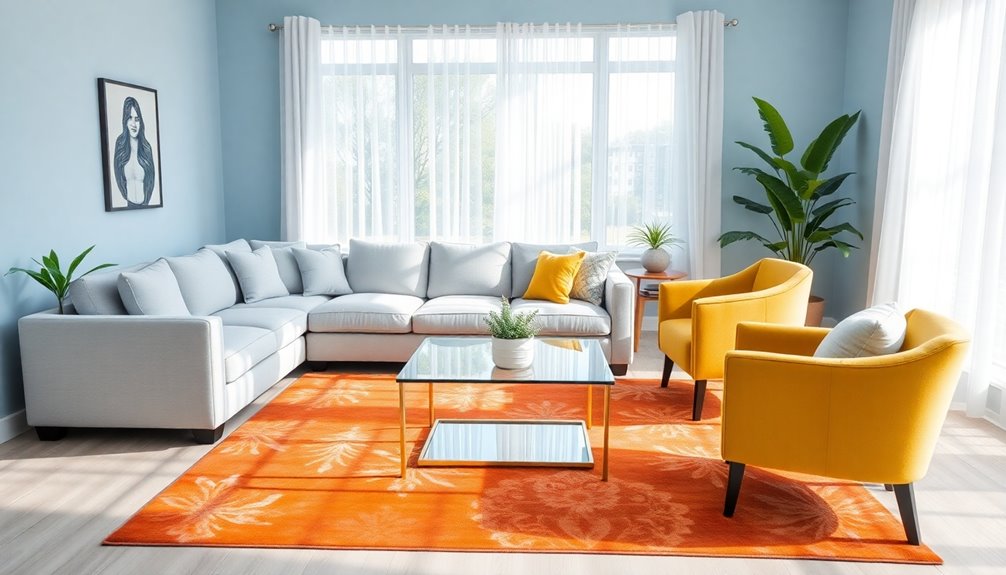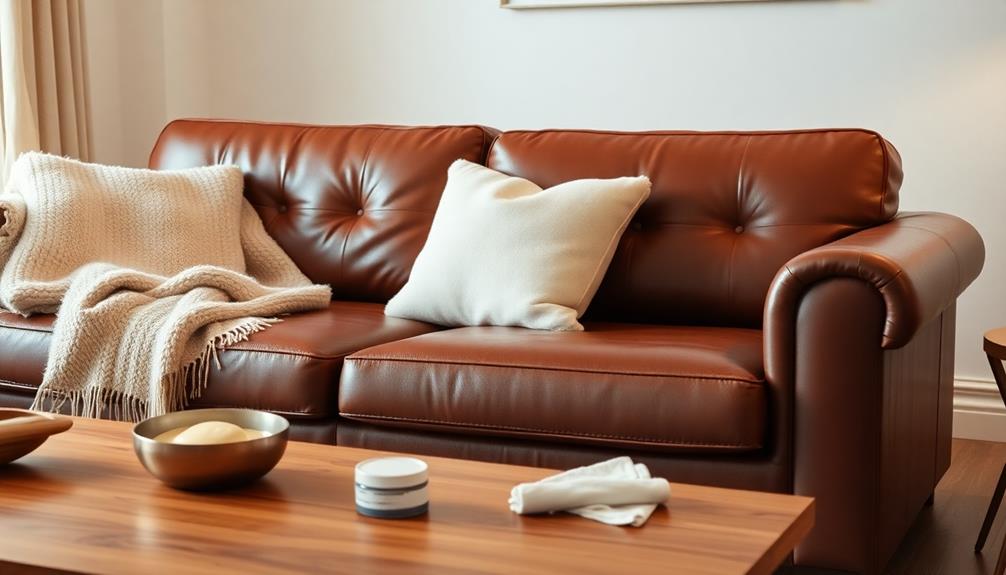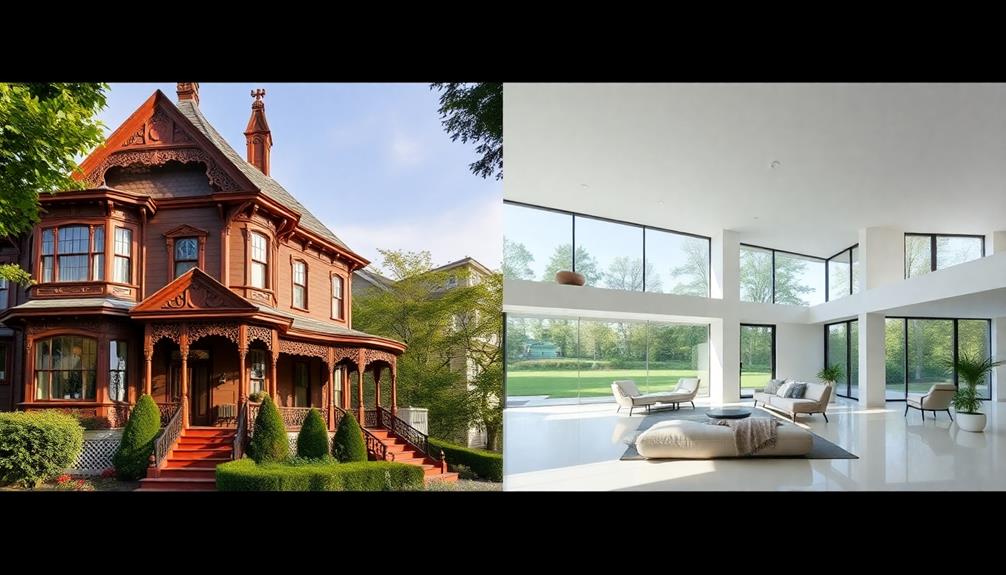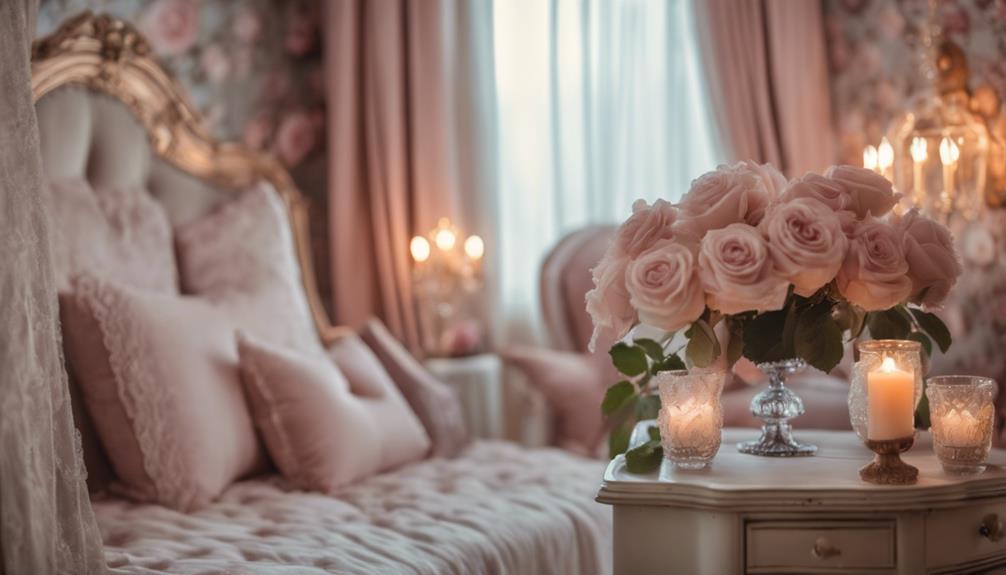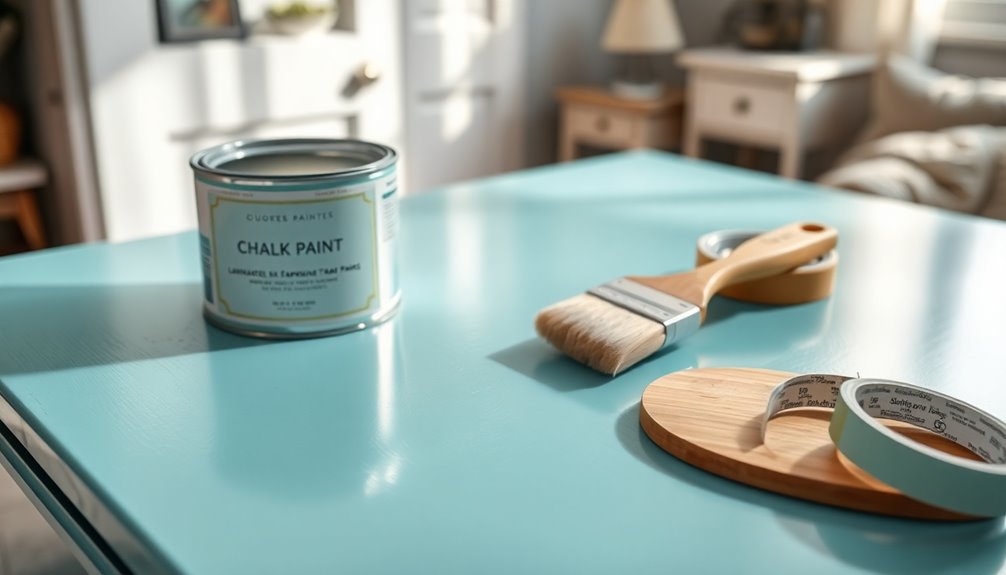To arrange furniture in a rectangular living room, start by measuring the space and creating a floor plan. Identify your focal point, like a fireplace or TV, and position your main seating facing it. Use a large rug to define the seating area, while keeping pathways clear for easy movement. Balance the room by placing larger furniture opposite each other and leaving enough space for walking. Consider multifunctional pieces to maximize utility and use light colors to create an open feel. There's more to learn about enhancing your living room's style and functionality, so keep exploring!
Key Takeaways
- Measure the room and create a floor plan to visualize furniture placement and identify architectural features and obstacles.
- Establish a focal point, such as a fireplace or TV, and arrange seating to face it for cohesion.
- Designate zones for different activities using rugs to define areas and maintain clear pathways for easy navigation.
- Balance the room with symmetrical arrangements and evenly distributed heavier furniture pieces to avoid visual clutter.
- Maximize space with multifunctional furniture and transparent pieces, while angling items to create depth and openness.
Understanding the Space
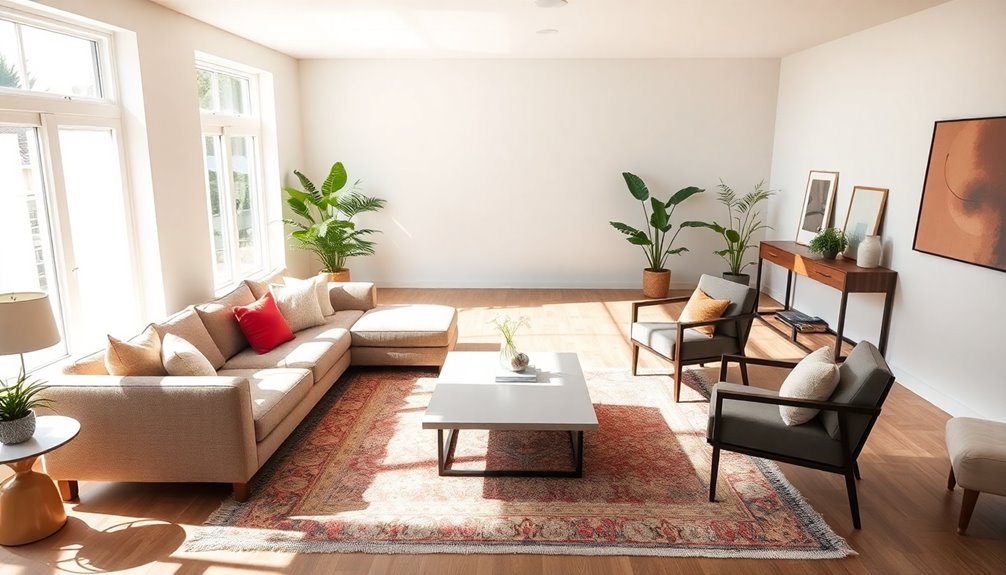
When you start arranging furniture in your living room, understanding the space is crucial to creating a functional and inviting layout. First, measure the room’s dimensions to get a clear idea of the available area. Create a floor plan to visualize the layout and pinpoint any potential issues. Don’t forget to note the locations of architectural features like windows, doors, and fireplaces, as these will significantly influence your design. Additionally, consider the flow of movement within the room to ensure that it feels open and accessible. When arranging furniture in small spaces, prioritize multifunctional pieces that maximize utility without overwhelming the area. Experiment with different configurations to find the best arrangement that reflects your style while maintaining comfort and practicality.
Identify any obstacles, such as electrical outlets and heating vents, that could be blocked by large furniture pieces. Ensure that doors don't obstruct traffic flow when opened. Consider how natural light from windows affects the ambiance of the room. Keep in mind the need for easy navigation; avoid placing bulky furniture in natural pathways and maintain sufficient space between pieces for comfortable movement.
Utilize corners and dead spaces effectively. Think about incorporating side cabinets, bookshelves, or wall-mounted units to maximize vertical space. Incorporating vintage or distressed furniture can add an authentic charm to the overall design. Concealed storage options can also help keep the room clutter-free. By assessing these elements, you'll create a harmonious layout that enhances both functionality and aesthetics in your living room.
Establishing a Focal Point
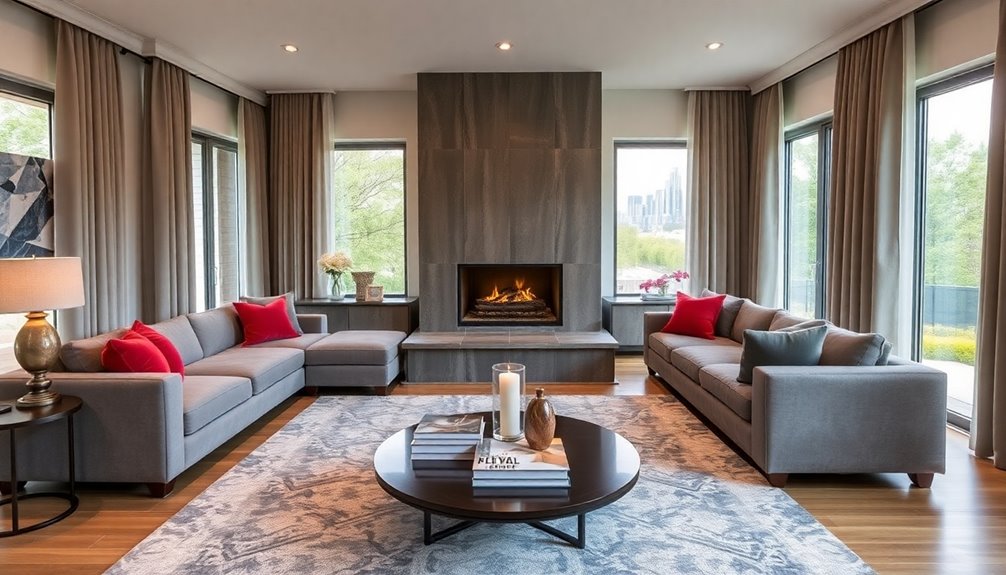
After you've assessed the space, the next step is to establish a focal point in your living room. Identify what catches your eye first—this could be a fireplace, a large window, or even a TV. Take note of any architectural features like French doors or grand mantels that naturally draw attention. The focal point will serve as an anchor for your room, guiding how you arrange your furniture.
Position your seating to face this focal point, ensuring that sofas and chairs are oriented toward it for a cohesive look. This arrangement promotes a sense of balance and harmony. Keep in mind that while you may have multiple focal points, it's crucial to designate one as the primary focus to avoid visual clutter. Creating a defined focal point will help ground the space, reducing emphasis on length.
If you have more than one focal point, balance their visual weight. Use larger decor pieces to enhance secondary focal points and employ color and texture to create links between them. Lighting can also play a significant role in balancing these elements. Ultimately, your goal is to ensure that the focal point remains the central attraction, with other elements supporting its prominence.
Creating Zones
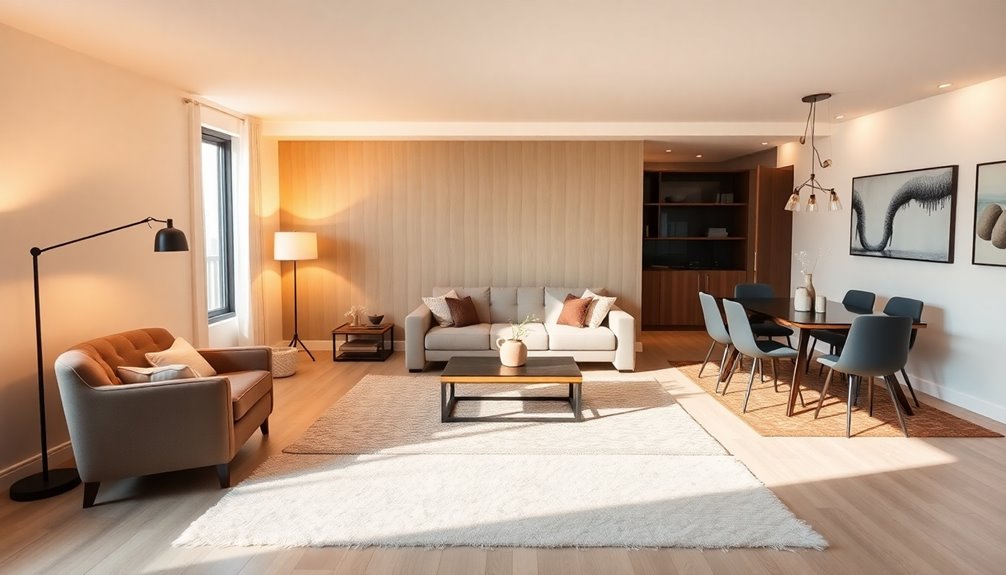
Creating distinct zones in your living room enhances functionality and flow. Start by designating a primary seating area for activities like reading, watching TV, or entertaining guests. A large rug under this main seating group helps define the space. Consider adding a secondary seating area or a desk for tasks like paying bills or homework, placing a smaller rug to distinguish it.
Utilize furniture wisely to create these zones. Sectionals or sofas can act as natural dividers, while accent pieces like credenzas further define each area. Keep furniture positioned away from walls to foster intimacy and comfort. You can also incorporate occasional chairs or pouffes that are easy to move, allowing flexibility in how you arrange the space. Avoid clustering all furniture at one end of the room to ensure a balanced layout.
Be mindful of traffic flow. Ensure there's enough room for comfortable navigation between furniture pieces, avoiding any obstructions in natural pathways. Use transparent furniture to create the illusion of more space, and consider round shapes to break up the room's rectangular layout. By implementing these strategies, you can create a cohesive living environment that caters to your needs and enhances your overall experience.
Balancing the Room
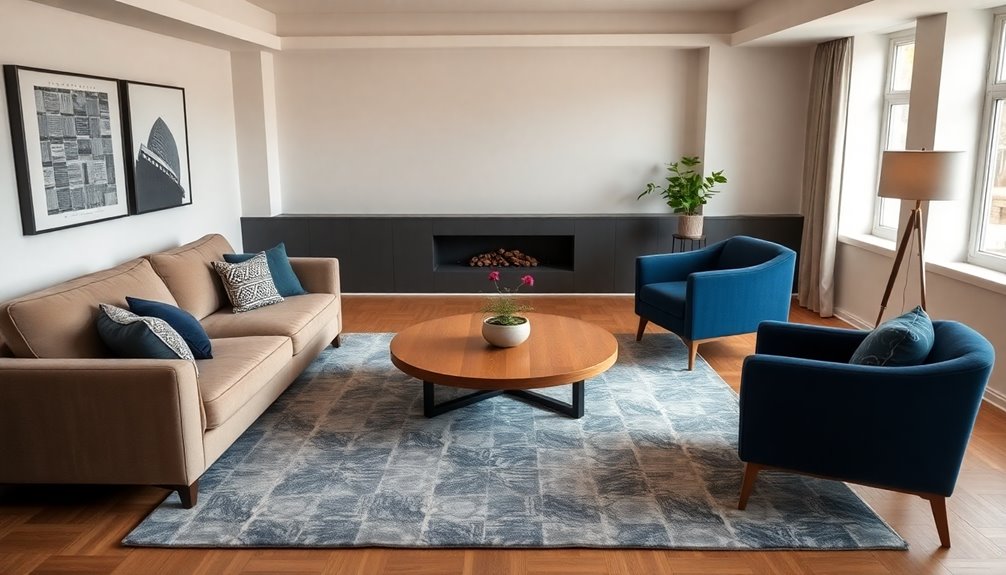
To achieve a harmonious living room, balancing the arrangement of furniture is key. Start by considering symmetrical arrangements, placing matching armchairs or side tables on either side of a focal point like a fireplace or TV. This symmetry creates visual balance and helps maintain a cohesive look, especially when dividing the room into zones.
Next, focus on central placement. Position larger furniture pieces, such as your sofa, towards the center to distract from the room's length and foster a more inviting atmosphere. Use a coffee table as your anchor, arranging seating around it while ensuring there's at least 12 inches of space from the walls. Identifying outlets and vents is also crucial to avoid obstructions in your layout.
Distributing weight evenly throughout the room is also vital. Place larger pieces opposite one another, like a couch facing a fireplace, to create a calming effect. Balance heavier furniture with smaller items to avoid overcrowding.
Lastly, consider traffic flow. Ensure there's ample space for navigation, leaving about three feet of walking space around furniture. This promotes easy movement and prevents congestion, making your living room a comfortable and inviting space.
Maximizing Space
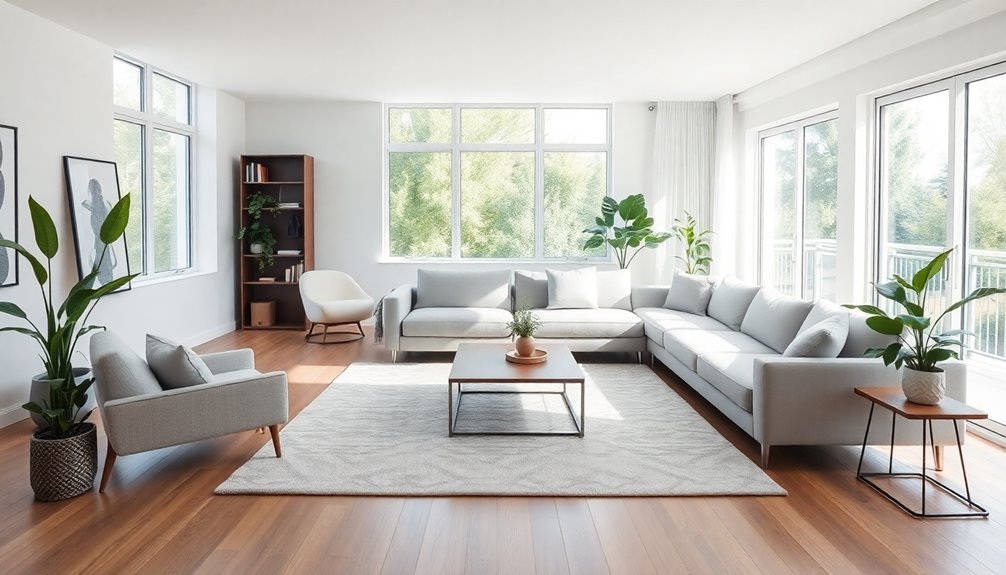
Often, maximizing space in your living room can transform how you use and enjoy the area. Start by choosing multifunctional furniture, like an entertainment unit that doubles as a study corner. Opt for pieces with legs to create an open feel and incorporate oval or round furniture to soften the room's rectangular shape. Sectionals are ideal for long, narrow spaces, while smaller accent chairs and tables can enhance versatility. It's also beneficial to consider facing sofas toward each other to promote conversation and create a welcoming atmosphere.
Utilize those often-ignored corners by placing side cabinets, bookshelves, or compact storage solutions like corner desks to keep the room clutter-free. Wall-mounted shelves are great for maximizing vertical space. When arranging furniture, keep large items on one side of the room, opposite doorways, to ensure smooth traffic flow. Avoid blocking natural pathways, windows, or fireplaces. Additionally, remember that bold colors can energize the space and create a more vibrant atmosphere.
To enhance visual space, consider glass or transparent furniture, and angle your pieces to add depth. Mount your TV to save floor space, and use table lamps instead of floor lamps to reduce clutter. Finally, maintain a clean, clutter-free look with your wall colors and decor, allowing the room to feel more open and inviting.
Frequently Asked Questions
What Are the Best Colors for Furniture in a Living Room?
When choosing colors for your living room furniture, consider neutral tones like white, grey, or beige for a calming effect. These colors easily blend with decor. If you want to add energy, vibrant accents like yellow or deep green can boost the mood. Earthy browns and rich marigold offer warmth, while bold blacks create a striking contrast. Aim for harmony by balancing these colors to ensure your space feels inviting and cohesive.
How Can I Incorporate Personal Decor Into My Furniture Arrangement?
To incorporate personal decor into your furniture arrangement, start by adding artwork or decorative pieces that resonate with your style. Display sentimental items to evoke fond memories and emotions. Use rugs to define different zones, creating warmth and visual interest. Position furniture around a focal point, like a favorite piece of art, ensuring it's balanced with your decor. Finally, mix textures and colors to enhance the overall vibe and reflect your personality.
Should I Choose Matching or Contrasting Furniture Styles?
When deciding between matching or contrasting furniture styles, consider your personal taste and the vibe you want. Matching sets can create a cohesive, traditional look, making coordination easy. On the other hand, contrasting styles add visual interest and allow for creative expression. Think about how each approach reflects your personality and the comfort you desire. Ultimately, choose what feels right for you, balancing aesthetics with functionality for the best result.
How Do I Maintain a Comfortable Temperature With Furniture Placement?
To maintain a comfortable temperature with furniture placement, you need to avoid blocking vents and radiators. Position larger pieces away from windows to prevent cold drafts and overheating from sunlight. Keep pathways clear for air circulation, and consider using furniture with legs to enhance airflow. Use rugs to define zones without obstructing heat distribution, ensuring the room stays cozy and inviting while promoting effective temperature regulation throughout the space.
What Types of Lighting Work Best for a Living Room?
For your living room, you'll want a mix of ambient, task, and accent lighting. Start with ambient lighting to set the mood, like dimmable LED ceiling lights. Add task lighting with adjustable table or floor lamps for activities like reading. Finally, incorporate accent lighting to highlight artwork or architectural features, using wall sconces or spotlights. Aim for warm white light to create a cozy atmosphere that complements your decor.
Conclusion
In conclusion, arranging furniture in your rectangular living room can transform the space into a welcoming haven. By understanding the layout, establishing a focal point, and creating functional zones, you'll enhance both style and comfort. Don't forget to balance the room and maximize the available space. With these tips in mind, you'll create a harmonious environment that reflects your personal taste and meets your lifestyle needs. Enjoy your beautifully arranged living room!
